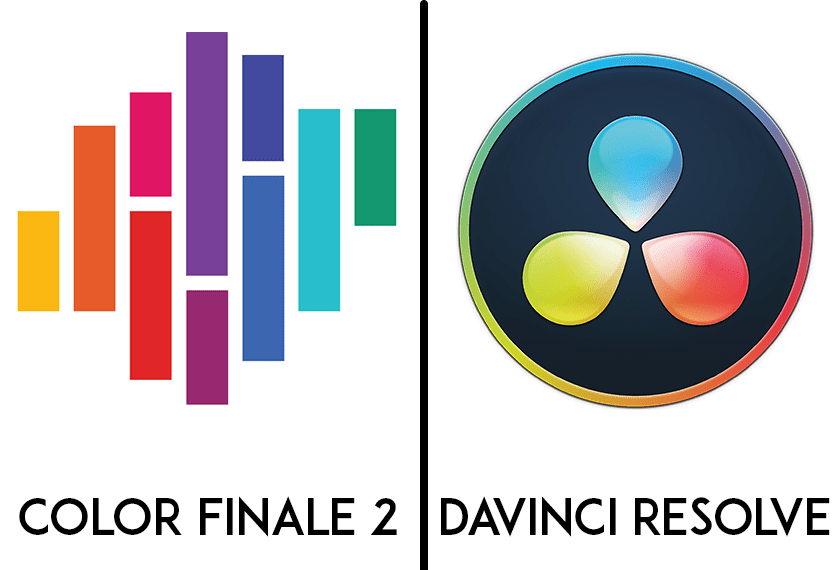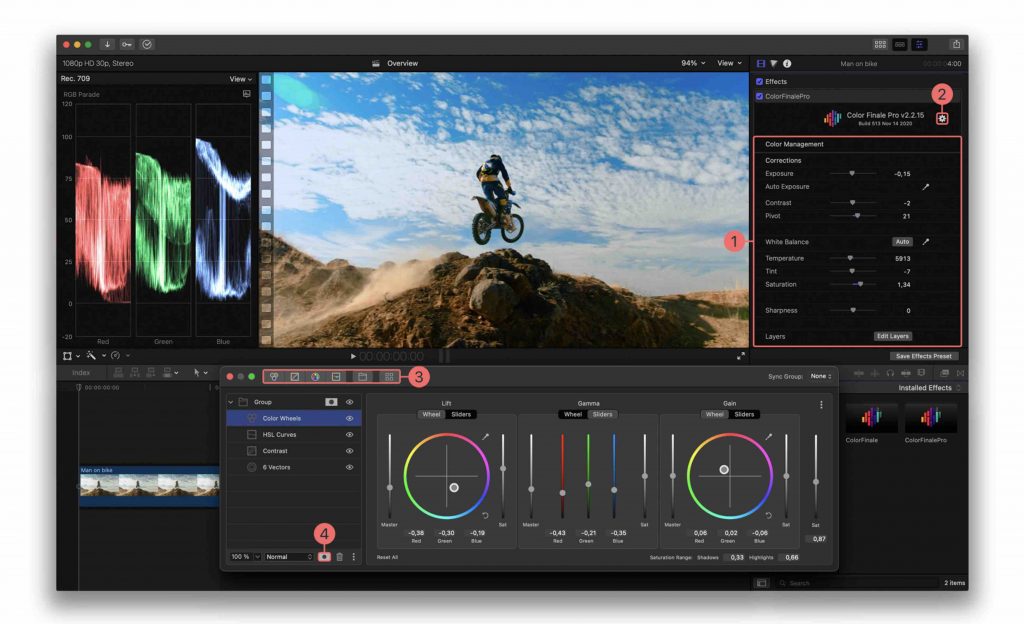If you’re looking to upgrade your color grading software, you may have found yourself wondering: which is better – Color Finale vs DaVinci Resolve? And that’s totally normal! These two color correction and color grading software are among the top choices for mid- to high-level video editors. And for good reason.
But, what makes each software so special? And, most importantly, which is the better software for color grading and correction?
Keep reading this breakdown of each platform to make an informed decision when you upgrade your video editing process!
First, let’s breakdown what each platform is and why they each standout.

What is Color Finale?
Color Finale from Color Trix is one of the best color correction and grading software available. It is downloaded as a plug-in and is currently only compatible with Final Cut Pro X. So, if you’re already using FCPX to edit your video, then Color Finale is something you’ll definitely want to consider.
The latest version of Color Finale, Color Finale 2, is extremely powerful. It provides a much more in-depth coloring experience than native Final Cut Pro coloring tools. Plus, it’s surprisingly easy to use. Once you’ve installed Color Finale 2, it will be available in the “Video Effects” section. You can simply drag and drop it onto specific clips. Or, create an adjustment layer for your whole video and apply it there.
Editors will have access to curves, vectors, color wheels and HSL curves. All of these can be applied in layers. And the layers are easy to reorder and manipulate.
Some of the coolest features with Color Finale 2 are the masking and an improved LUTs browser. Masks are simple to apply to video clips and easy to manage with an excellent tracking feature. This allows editors to more easily isolate specific areas or colors within footage for detailed coloring.
And, as mentioned, the LUTs browser has been upgraded since Color Finale 1. It is now much easier to sort through and preview LUTs. Plus, you can show Color Finale where your favorite LUTs are located on your computer for quick application. Or, you can create your own LUTs and save them for use on future projects.
All of these tools provide a very detailed coloring experience. But the best part of it all is that Color Finale is actually simple to use. You can find a lot of great Color Finale tutorials at their YouTube channel too.
You can purchase the basic Color Finale 2 software for $99. Or, purchase Color Finale 2 Pro for the full suite of features for a one-time payment of $149.
Click here to start your FREE trial of Color Finale 2! Or visit our review of Color Finale 2 to learn more.
What is DaVinci Resolve?
DaVinci Resolve from Blackmagic is one of the most powerful color correction and color grading software video editors can use. In fact, it’s become popular among even film and TV editors. That’s because DaVinci Resolve was built specifically for creating beautiful colors in video.
Unlike Color Finale 2, DaVinci Resolve is a standalone program. You can’t use it with Adobe Premiere or Final Cut Pro X. One of the benefits to using DaVinci Resolve is that you can actually edit your footage in the program. That means you can make cuts and add text, effects and transitions to your edits all within DaVinci Resolve.
And if you’re switching from a popular video editor like FCPX or Adobe Premiere, you’ll definitely face a learning curve. That’s because DaVinci Resolve uses a system called “nodes” for adding effects to footage.
Resolve features powerful AI tools that help editors match colors in a snap. It also has powerful noise reduction features that are excellent for grainy footage.
Resolve’s coloring tools are top notch… but they come at a price. Users who choose DaVinci Resolve should have a high-end processor to keep up with the program’s demands. And, again, be ready to spend many hours learning the node system.
Perhaps the best part of Resolve is that there is a robust free version available. Some of the features missing from the free version include the DaVinci Neural Engine, some Resolve FX filters, stereoscopic 3D tools and a few other features. The full version, DaVinci Resolve Studio 17, will cost you a one-time payment of $295.
Click here to try DaVinci Resolve!
Now, let’s do a direct comparison of the two programs and see which comes out ahead.
DaVinci Resolve vs Color Finale
In this section, we’ll compare five main features that editors might be looking for in a color grading software. This isn’t a complete comparison, but it should give you a good picture of which is better suited for your needs.
Ease of Use – Color Finale 2
Color Finale 2 is an easy winner in this category. For FCPX editors, all you need to do is download the program. Next time you open FCPX, it’ll be available to use. And, editors more knowledgable with Premiere Pro will still have an easier time with Color Finale vs DaVinci Resolve. This is because DaVinci Resolve uses a completely different system for editing video than other programs. The learning curve is extremely steep with Resolve. But with Color Finale 2, watch a couple tutorials and you’ll be on your way.
Coloring Tools – DaVinci Resolve
DaVinci Resolve is absolutely the most powerful color grading software available for video editors today. It’s a popular choice in Hollywood because of these features. Resolve features all of the classic color wheels and meters that you expect from a coloring program. But it also utilizes powerful AI to help editors do things, like color match, more quickly.
Additional (Non-Coloring) Features – DaVinci Resolve
DaVinci Resolve again gets the nod here. And that’s simply because it is a standalone video editor with plenty of features. You can cut video, apply text, effects and transitions all within the powerful DaVinci Resolve software. And editors who purchase the full version of Resolve will get even extra bang for their buck. Over 100 high quality effects are included with Resolve FX. Plus, features like Fusion (for motion graphics and visual effects) and Fairlight (for professional audio post production) make Resolve a one-stop-shop.
Price – DaVinci Resolve
You can’t beat free. And that’s exactly what you get with DaVinci Resolve. No, you don’t get the full suite of features with the free version of Resolve. But you do get an extremely robust editor. However, it’s hard to knock Color Finale 2 here. You can get the full Color Finale 2 Pro for just $149, compared to $295 for Resolve.
So, What’s Better – Color Finale vs DaVinci Resolve
DaVinci Resolve is definitely the better color grading and video editing software. So, if you’re looking to find out which is more powerful, there’s your answer.
However, video editors comfortable with Final Cut Pro X would be better off using Color Finale 2. And that goes for Premiere users who are open to switching to FCPX (Color Finale is DEFINITELY better than Lumetri). The learning curve on DaVinci Resolve is steep. And unless you have dozens of hours to dedicate to learning the new system, you’ll find using Resolve to be extremely frustrating.
So at the end of the day, the answer really comes down to you, the video editor. If coloring is the most important part of the video editing process for you, then give DaVinci Resolve a go. But if you’re committed to using the editing software you already have (and that software is FCPX), then Color Finale 2 is definitely the option for you. We would also recommend Color Finale 2 for amateur editors who are looking to publish non-professional videos to a platform like YouTube.
And if you’re looking for more options, check out our list of the 5 best color grading software here.

2 comments
Great and very helpful article. The thing I would have appreciated learning more about is ProRes vs. BRAW. I’m currently using a BMCC6K Pro camera. If you’re using FCPX you’ll probably be using Pro Res. If you’re using DaVinci you’ll probably want to use BRAW. My question is, if you’re using Color Finale with Pro Res will your end result be significantly different than if you used BRAW in DaVinci?
That’s a good question. There shouldn’t be much difference but I can’t say for sure. If we come across this situation we’ll update this reply. And if you find a difference, please let us know! Thanks for stopping by.